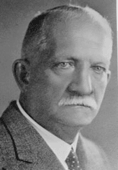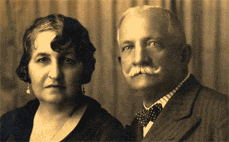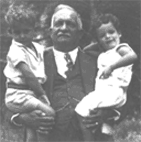To
the memory of Dr. Alfredo Jahn II
Web Page by
his grandson Alfredo Jahn IV
 |
 |
 |
Compiled by: Architect Gonzalo Velez Jahn (November 1989)
Translation by: Architect Alfredo Jahn (January 2004)
Venezuelan geographer, botanist and civil engineer.
1867
Born in Caracas on October 8th, son of Alfredo Federico Jahn and Eugenia Hartmann.
1872
Starts his grammar school in Caracas, Venezuela.
1876
Sent by his fathers to the City of Hannover, Germany where he starts his High school. Later he is sent to the famous “Torgau” Gym under the guidance of his uncle who was the artillery commander of that fortress.
1882
He goes to Berlin and later to the Hannover engineering school.
He returns to Caracas due to family reasons and continues his studies at the University of Venezuela where he also studies natural science under professor Adolph Ernst.
1884
He climbs the Avila mountain to the “Silla de Caracas” and the “Naiguata” peak.
1886
He starts as auxiliary engineer in the construction of a railroad, property of a British firm.
He travels to the “Colonia Tovar” from La Victoria on February 28th to march 10th and stays there march 8th and 9th. During that stay he draws the petrogliphs south of the “Colonia Tovar”.
During that year he finishes his engineering studies at the University of Venezuela
1887
As auxiliary engineer, he accompanies Chief engineer L.A. Müller from Krupp Engineering for the preliminary studies for the construction of the “Great Venezuelan Railway” between Caracas and Valencia.
During the preparations to initiate the construction of the “Great Venezuelan Railway” he accompanied the eminent Chemist Vicente Marcano as a botanist and geographer during an ethnological expedition sent by President Guzman Blanco to the high Orinoco river.
Reestablished, he climbs Buena vista peak (Dec. 12th); Galipán peak (Dec. 21st); Curtidoral peak (Dec. 23rd). On December 27th he travels to Guarenas, State of Miranda.
Upon his return to Caracas he climbs the Avila mountain again.
1888
The German firm in charge of the construction of the “Great Venezuelan Railway” hires him to study the final lay out for the first 62 kilometers in the difficult mountain region.
1891
He marries Aurelia Lopez on July 25 Th.
He is designated founder of the Venezuelan Society of Civil Engineering on the 5th of July.
1892
Due to his work in the “Great Venezuelan Railway” he establishes his home in the City of Maracay where he lives until February 1894.
On the 13th of July his first child is born, a daughter, Maria Aurelia.
1893
On the 23rd of August his second daughter is born, Eugenia Jahn L. , in the City of Maracay, State of Aragua.
1894
In February concludes the first section of railroad.
He starts to work in La Victoria as chief engineer of the planes section of the railroad, and stays there until his final separation from the railroad in 1902.
1895
On the 4th of April his first boy in born in La Victoria, Alfredo.
1896
On the 25th of September his second boy is born, Gustavo.
1898
On the 6th of October his third girl is born, Margarita.
1899
On the 19th of December his third boy is born, Carlos.
1900
His meteorological observations practiced in La Victoria are compiled.
1901
On the 21st of June his forth girl is born, Luisa Cristina.
1902
Due to political disturbances in Venezuela, he definitely separates prom the railroad works.
During his long ten year stay in the states of Aragua and Carabobo as railroad engineer he made a survey between Caracas and Valencia, and also of the Valencia Lake and his surrounding mountains.
1903
He continues with his geographical work in the “Tuy” valley and the mountains near Caracas.
1904
On the 30th of September his fifth girl is born, Carmen.
1905
On the 27th of March his sixth girl is born, Angelina.
1906
While he is the technical director of the Caracas - La Guaira Railway, he makes a survey to determine the exact height above sea level of the City of Caracas and of the “Cajigal” observatory.
1907
On the 30th of January his seventh girl is born, Isabel.
1908
He starts the construction of the Hydroelectric plant of “Mamo” using his own project and drawings, that later were adopted by the renown British firm J.C. White & Co. of London, for the completion of that important project.
He explores the area now occupied by the “Guatopo” National Park y the State of Miranda.
1909
On the second day of January his last girl is born, Beatriz Elena, she died after a few months.
Appointed in January Director of the Technical Office of the Ministry of Public Works, he is designated Chief Inspector of the Venezuelan Railways. In that position he visits the State of Tachira - La Ceiba Railway, taking advantage of that visit he makes his first geographical and botanical survey of the Venezuelan Andes mountains between the City of Valera an San Cristobal.
He is appointed by the Venezuelan Government High Commissioner for negotiation of railway properties between Puerto Cabello and Valencia.
1910
Explores the Merida mountain region (sierra nevada) and the highest peak in Venezuela (Bolivar peak) for the first time, gives the Humboldt peak its name.
Designated by the Ministry of Public Works he undertakes, between July 1910 and April 1912, as Chief Engineer of the Scientific Commission for the exploration of the western part of Venezuela, a detailed geographical exploration of the Andes Region and the Colombian border. During his return to Caracas he explores the upper part of the Apure river and the plains of Apure, Barinas, Portuguesa, Cojedes and Guarico States.
1911
Is designated by the Ministry of Public Works, with Engineer German Jimenez, to inspect the piers of the port of Puerto Cabello, built in 1897, to determine the damages due to the collisions of large steamships.
He prepares technical information for the project of the roads between the City of Merida and El Vigia and also the main roads of the Tachira State. These roads were later built by Engineer Luis Velez Briceño.
He explores all towns and mountains in the Tachira State.
The Venezuelan Government entrusts him with the study of “Independence Colony” in the State of Miranda, region occupied today by the Guatopo National Park.
1912
He publishes his important work “Orography of the Venezuelan Andes Mountain Range” with maps, photographs and heights.
1914
Between 1914 and 1915, with his own savings, and without official help, in order to complete a map of the Venezuelan western region, he surveys the coast of the Maracaibo Lake between San Lorenzo and Santa Maria, he visits the territory of the Paraujanos and Guajiros Indians and explores the northern slopes of the Andes mountain region, at the same time he directs the construction of the “Sucre” Sugar Mill near Bobures.
1915
Between 1915 and 1925 he acts as President of the Central Immigration Board of Venezuela.
1917
He publishes "El Origen del Bananero en America" (The Origin of the banana Tree in America) through the magazine "Cultura Venezolana" (Venezuelan Culture).
1918
He publishes "El Hipsometro como Instrumento de Viaje" (the Hypsometer as a Traveling Instrument) through the magazine of the Venezuelan Engineering Association.
He also publishes "Contribución al Estudio de la Climatología en Venezuela" (Contribution to Climatologically Studies in Venezuela) through the magazine "Cultura Venezolana" (Venezuelan Culture).
Publishes "Problemas Antropológicos y Etnológicos Americanos" (Ethnological and Anthropological Problems in America).
1919
He publishes "La Altitud de Caracas" (The Elevation of Caracas) through the magazine of the Venezuelan Engineering Association.
1921
During his government commission for the study and construction of the Andes roadways, he directs his geographical, geological and botanical investigations to the mountain region south of Merida and Tovar. The 15th of august he sails to the southern part of the Maracaibo lake where he surveys the Escalante river.
1922
Through his explorations in Trujillo, Merida, Portuguesa y Zamora he obtains geographical coordinates for 137 towns and points of interest a great number of altitudes, that permits him to elaborate his map of the Venezuelan Andes Mountains. He collects and classifies over 1300 plants mostly from the Andes region. 22 of these plants bear his name. The entire collection is at the Smithsonian Institute in Washington D.C.
1923
The 25th of February he is designated as member of the Academy of National History pronouncing a speech about the pre-Columbian people of the Maracaibo Lake. He explores the mountains at Batatal. He is contracted by the Carenero Railroad to build a metallic bridge over the Tuy River with a 60 metes span. He builds the new bridge in 5 moths.
He is designated member of the Venezuelan chapter of the inter-American High Commission.
1924
Invited by the United States Government he attends the U.S. Highway Commission at Washington D.C. and travels as honorary representative of Venezuela, as so is made member of the American Road Builders Association.
That same year he is made member of the American Geographic Society.
1925
The Venezuelan Government names him official delegate before the Pan-American Road Congress in Buenos Aires, Argentina. He returns via Sao Paulo in order to study the growth of Coffee plants, he is named member of the Brazilian Rural Society.
He visits the Andes Roadway by car to make altitude findings, that are publishes in the year 1933 in the magazine of the Ministry of Public Works.
1926
He presents a paper in the 5th Road Congress in Milan, Italy regarding the roads in Venezuela. That year he finishes his book named Los Aborígenes del Occidente de Venezuela. (the Natives of Western Venezuela)
1927
He publishes his most known book “Los Aborígenes del Occidente de Venezuela: su historia, etnografía y afinidades lingüísticas” (the Natives of Western Venezuela, their history, customs and languages) (Caracas, litografía del Comercio) in memory of Theodor Koch Grunberg.
He is elected President of the Central Agriculture Comity crated by the Venezuelan Government.
1928
The Berlin Geographical Society honors him with the Nachtingal Medal, crated to reward merits in geographical investigations. The University of Hamburg, to recognize his findings an work confers him the degree of Doctor honoris-causa in Natural Science.
He publishes his work “Topographical and oil concession map of Northern Venezuela”
1929
He travels to Sevilla, Spain, where he represents Venezuela in the International Agricultural Congress.
1930
The Venezuelan Engineering Association names him honorary member in reward for his work in favor of the geography in Venezuela. The New York Geographical Society makes him Honorary Member for his work in behalf of geography.
He travels to Puerto La Cruz and Colonia Tovar where he makes barometric observations and studies to build a road between Caracas an la Colonia Tovar.
The 5th of October he pronounces the address in the 100 anniversary of Adolf Ernst.
1931
In February, with other scientists he founds the Venezuelan Natural Science Society, and is designated Vice-president. In 1932 at the death of Dr. Luis Razzeti, is elected President.
1932
The Ministry of public Works names him as a member of the commission to study the coordination between vehicle and railroad traffic in the country, position that he holds until October 1933 when the report is delivered to the Ministry.
Publishes his book: “The deformed skulls of the aborigines of the Aragua valleys”.
1933
The Academy of Physical, Mathematical and Natural Sciences, installed by executive resolution on the 14th of June, elects him as second vice-president and commends him with the inaugural address. In April he pronounces the address for the inaugural act of the bust of General Agustin Codazzi in the Academic Palace.
1934
Initiates the publication of the bulletin of the Venezuelan Natural Science Society of important material compiled by him regarding the foundation of the “Colonia Tovar”.
1935
He is designated first vice-president of the Academy of Physical, Mathematical and Natural Sciences for the period 1935/1937. In June he is named president of the Coffee Growers Association of Venezuela. Is reelected in 1936 and resigns in 1937. The national assembly decides to name him honorary president and in his honor places his picture in the hall of sessions. Also he figures in the editorial commission for the bulletin of the Academy of Physical, Mathematical and Natural Sciences
1937
In February he is designated president of the the Venezuelan Natural Science Society for a third period. In July he is elected representative of the Coffee Growers Association of Venezuela to the Pan-American coffee conference. In July is reelected vice-president of The Academy of Physical, Mathematical and Natural Sciences for the period 1937 to 1939.
1938
In February he is designated president of the the Venezuelan Natural Science Society for a forth period. He publishes in the society’s bulletin “Documents for the history of the Colonia Tovar” and his story “Excursions and mountain climbing: History and evolution” and “The Expedition of the American Museum of Natural History to the Auyantepuy mountain”.
1939
He is designated Deputy Director of Venezuelan Historical Academy, President of the Venezuelan Natural Science Society and vice-president of The Academy of Physical, Mathematical and Natural Sciences
1940
He passes away on the 12th of June at the age of 72.
PHOTOGRAPHIC GALLERY
 1890 |
 1935 |
 1887 |
 1931 |
 1940 |
